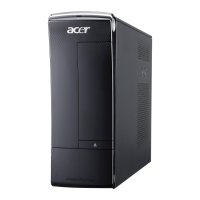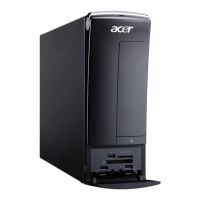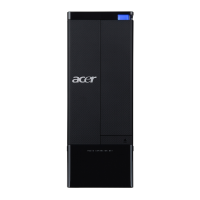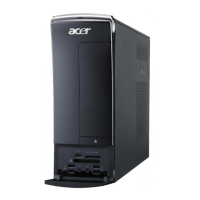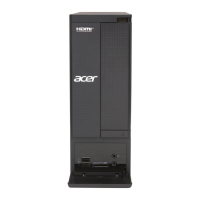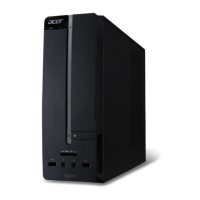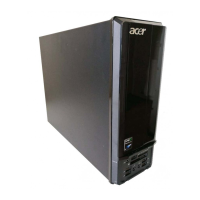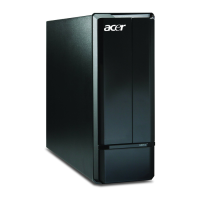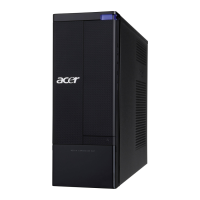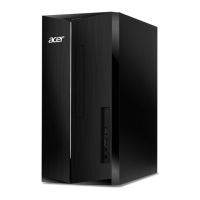K
Katherine ChapmanSep 8, 2025
What does 'Gate20 Error' mean on Acer Aspire X3950 Desktop?
- OOmar LeeSep 8, 2025
If your Acer Desktop displays 'Gate20 Error', this may indicate a problem with the mainboard.
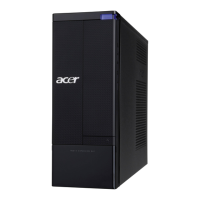
What does 'Gate20 Error' mean on Acer Aspire X3950 Desktop?
If your Acer Desktop displays 'Gate20 Error', this may indicate a problem with the mainboard.
What does 'Multi-Bit ECC Error' mean on Acer Desktop?
If your Acer Desktop displays 'Multi-Bit ECC Error', this may indicate a defective memory module.
What to do if problem is not evident after internal inspection of Acer Aspire X3950?
If the problem with your Acer Desktop is not evident after internal inspection, try viewing the POST messages and BIOS event logs during the system startup.
What does 'DMA-1 Error' or 'DMA-2 Error' mean on Acer Aspire X3950?
If your Acer Desktop displays 'DMA-1 Error' or 'DMA-2 Error', this often indicates a problem with system hardware.
How to fix 'CMOS Date/Time Not Set' on Acer Desktop?
If your Acer Desktop displays 'CMOS Date/Time Not Set', try readjusting the system time in AMIBIOS Setup.
| Tcase | 72.6 °C |
|---|---|
| Bus type | DMI |
| Stepping | C2 |
| Processor cache | 4 MB |
| Processor cores | 2 |
| Processor model | i3-530 |
| System bus rate | 2.5 GT/s |
| Processor family | Intel® Core™ i3 |
| Processor series | Intel Core i3-500 Desktop Series |
| Processor socket | LGA 1156 (Socket H) |
| Processor threads | 4 |
| Processor codename | Clarkdale |
| Processing Die size | 81 mm² |
| Processor frequency | 2.93 GHz |
| Processor cache type | Smart Cache |
| Processor lithography | 32 nm |
| Processor manufacturer | Intel |
| Processor front side bus | - MHz |
| PCI Express slots version | 2.0 |
| Processor operating modes | 64-bit |
| ECC supported by processor | No |
| PCI Express configurations | 1x16, 2x8 |
| Thermal Design Power (TDP) | 73 W |
| Number of processors installed | 1 |
| CPU multiplier (bus/core ratio) | 22 |
| Maximum number of PCI Express lanes | 16 |
| Memory types supported by processor | DDR3 1066/1333 |
| Number of Processing Die Transistors | 382 M |
| Memory bandwidth supported by processor (max) | 21 GB/s |
| Maximum internal memory supported by processor | 16 GB |
| Product type | PC |
| Motherboard chipset | Intel® H57 Express |
| Networking features | Gigabit Ethernet |
| Graphics card family | NVIDIA |
| Memory slots | 4x DIMM |
| Internal memory | 4 GB |
| Memory channels | Dual-channel |
| Memory clock speed | 1333 MHz |
| Internal memory type | DDR3-SDRAM |
| Maximum internal memory | 8 GB |
| Memory layout (slots x size) | - GB |
| HDD interface | SATA |
| Optical drive type | - |
| Card reader integrated | Yes |
| Total storage capacity | 320 GB |
| Discrete graphics card model | 315 |
| Maximum graphics card memory | 0.5 GB |
| On-board graphics card model | Intel® HD Graphics |
| On-board graphics card base frequency | 733 MHz |
| Operating system installed | Windows 7 Home Premium |
| Headphone outputs | 3 |
| USB 2.0 ports quantity | 11 |
| Firewire (IEEE 1394) ports | 0 |
| Power supply | 220 W |
| Chassis type | SFF |
| Product color | Black |
| Processor ARK ID | 46472 |
| Processor package size | 37.5 x 37.5 mm |
| Graphics & IMC lithography | 45 nm |
| Supported instruction sets | SSE4.2 |
| Physical Address Extension (PAE) | 36 bit |
| Depth | 371 mm |
|---|---|
| Width | 100 mm |
| Height | 265 mm |
Accessing and using the CMOS Setup Utility for system configuration.
Step-by-step instructions on how to remove the side panel.
Guide on how to remove the CPU from the motherboard socket.
Step-by-step guide on how to remove the motherboard from the chassis.
General procedure for diagnosing hardware problems using diagnostic tests.
Describes various error messages encountered during POST.
Explains beep codes indicating serious or fatal errors before video initialization.
